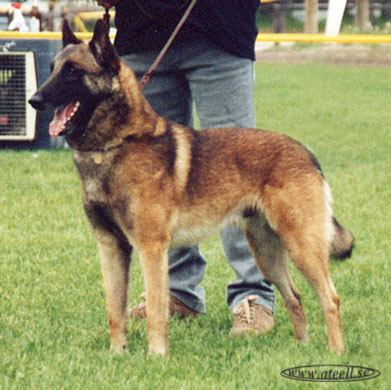If the Belgian Malinois could be summed up in one word, many people might use the term “active” to describe them. While they have several other qualities including being intelligent, agile, and loyal, it must be stressed that the Malinois was bred to be a working dog. As such, they have more energy than the average person would prefer in a pet, combined with a desire to work that must be met with an owner just as concerned with fulfilling that need.
This is not a good match for a first-time dog owner… even people who have owned dogs their entire lives are surprised at the energy and drive that these dogs possess! For experienced dog owners looking for a breed to train and compete with seriously, however, the Malinois might be a good fit. The breed can be a great contender in many different dog sports including tracking, obedience, herding, agility, conformation, flyball, lure coursing, and protection sports.
Dogs which are not trained and worked frequently (daily or every couple of days) tend to get bored and destructive. The same goes for Malinois that do not receive daily exercise! Training these dogs can be a lot of fun, as they are extremely fast learners and they have a great desire to please! That said, some can be sensitive to harsher corrections so care must be taken to find a correction level that is “just right” for the dog. The Malinois temperament can vary, from quite friendly to more serious to slightly aloof. Obedience training should be conducted with your specific dog’s temperament in mind.
Some Malinois can become protective of their “people” and territorial of their house/yard. If this behavior starts up, the owner needs to consider two things. First, does the owner want the dog to be a protection/guard dog? Second, is the behavior based on fear or is it natural guarding instinct? The Belgian Malinois is considered a protection breed. He is used in police work and as a home security dog because he has been bred for these traits. Anyone wanting to own one needs to be aware of this. He is never going to be a friendly Labrador, welcoming strangers into an empty house. However, depending on how protective the owner wants the dog to be, he can often be shaped and molded to better fit their lifestyle. Someone who doesn’t want a guard dog might be able to shape the dog into something more akin to an alert dog, with training. Someone else, who might prefer a personal protection dog, needs to seek the specific training for that.
A Malinois that is barking or lunging out of fear needs to be evaluated by a trainer who knows how to turn that fear into confidence. It should be noted that a fearful or aggressive Malinois is not typical, provided that the dog was well-bred and well-socialized by his owners. Protective does not equate with aggressive. Another trait to watch for is nipping/herding behavior. Because they were bred to herd livestock, this behavior comes natural to them. That energy should be channeled into more acceptable activities.
A fenced yard is recommended so that your Malinois can run and play freely without the worry of him trying to herd cars and subsequently getting hit. This is not a breed that can be left outside by himself, however. He definitely needs and thrives off of human interaction, more so than many other breeds. The breed is very attentive and loving of their owners, whether adults or children, often following them from room to room.
Malinois can be good with kids, however it must be stressed that the children need to be taught how to interact fairly with the dog. This goes for a dog of any breed. Older children tend to do better than younger ones, however, as this breed does like to rough-house and could unintentionally harm a young kid.

“Hameau-St-Blaise-Yuppie-01” by own – Own work.
